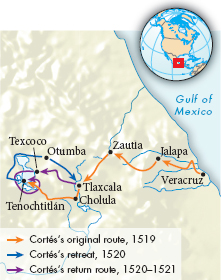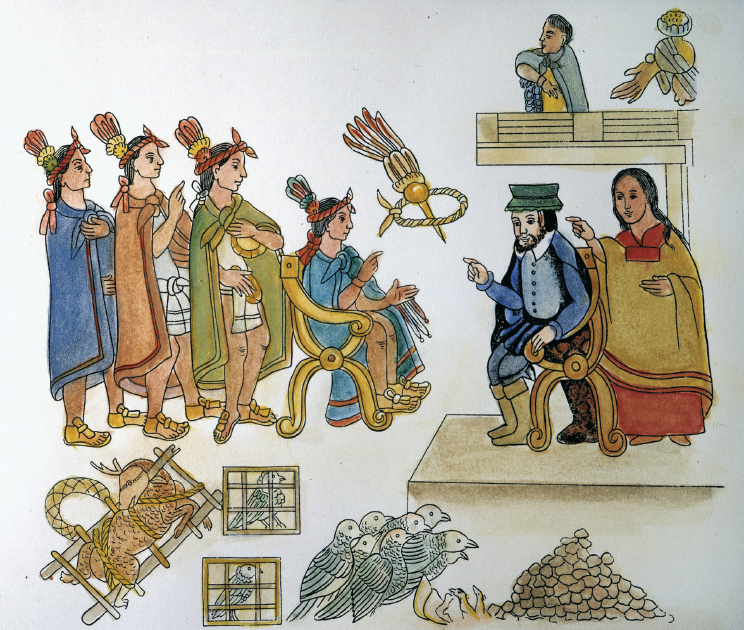Spanish Conquest in the New World
In 1519, the year Magellan departed on his worldwide expedition, the Spanish sent an exploratory expedition from their post in Cuba to the mainland under the command of the conquistador (kahn-
The Mexica Empire was ruled by Montezuma II (r. 1502–
Cortés landed on the coast of the Gulf of Mexico on April 21, 1519. The Spanish camp was soon visited by delegations of unarmed Mexica leaders bearing lavish gifts and news of their great emperor. (See “Picturing the Past: Doña Marina Translating for Hernando Cortés.”) Impressed with the wealth of the local people, Cortés soon began to exploit internal dissension within the empire to his own advantage.
Cortés quickly forged an alliance with the Tlaxcalas (Tlah-
Uncertain of how he should respond, Montezuma refrained from attacking the Spaniards as they advanced toward his capital and welcomed Cortés and his men into Tenochtitlán. His hesitation proved disastrous. When Cortés took Montezuma hostage and tried to rule the Mexica through the emperor’s authority, Montezuma’s influence over his people crumbled.

In May 1520, Spanish forces massacred Mexica warriors dancing at an indigenous festival. This act provoked an uprising within Tenochtitlán, during which Montezuma was killed. The Spaniards and their allies escaped from the city and began gathering forces against the Mexica. One year later, in May 1521, Cortés laid siege to Tenochtitlán at the head of an army of approximately 1,000 Spanish and 75,000 native warriors.4 Spanish victory in August 1521 resulted from Spain’s superior technology and the effects of the siege and smallpox. After the defeat of Tenochtitlán, Cortés and other conquistadors began the systematic conquest of Mexico.
More surprising than the defeat of the Mexica was the fall of the remote Inca Empire. Like the Mexica, the Incas had created a civilization that rivaled that of the Europeans in population and complexity. To unite their vast and well-
At the time of the Spanish invasion, the Inca Empire had been weakened by an epidemic of disease, possibly smallpox. Even worse, the empire had been embroiled in a civil war over succession. Francisco Pizarro (ca. 1475–
Like Montezuma in Mexico, Atahualpa was aware of the Spaniards’ movements. He sent envoys to invite the Spanish to meet him in the provincial town of Cajamarca. His plan was to lure the Spanish into a trap. With an army of some forty thousand men stationed nearby, Atahualpa felt he had little to fear. Instead, the Spaniards ambushed and captured him, collected an enormous ransom in gold, and then executed him in 1533. The Spanish now marched on the capital of the empire itself, profiting once again from internal conflicts to form alliances with local peoples. When Cuzco fell in 1533, the Spanish plundered immense riches in gold and silver.

CONNECTIONS: How do you think the native rulers negotiating with Cortés might have viewed her? What about a Spanish viewer of this image? What does the absence of other women here suggest about the role of women in these societies?